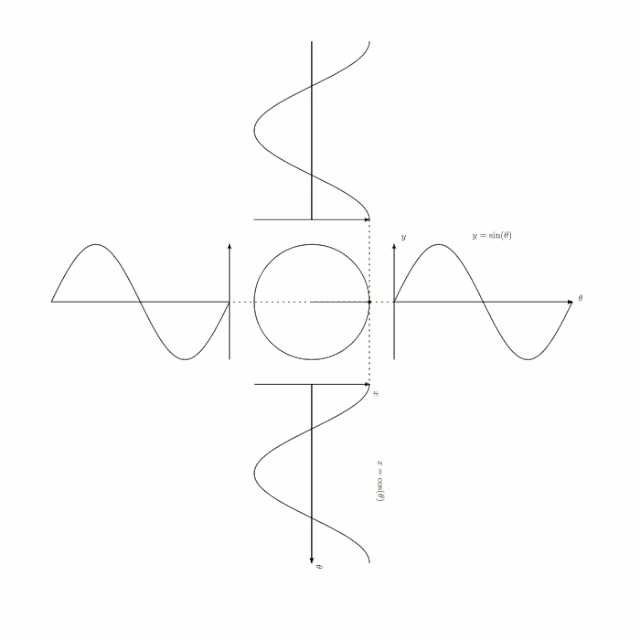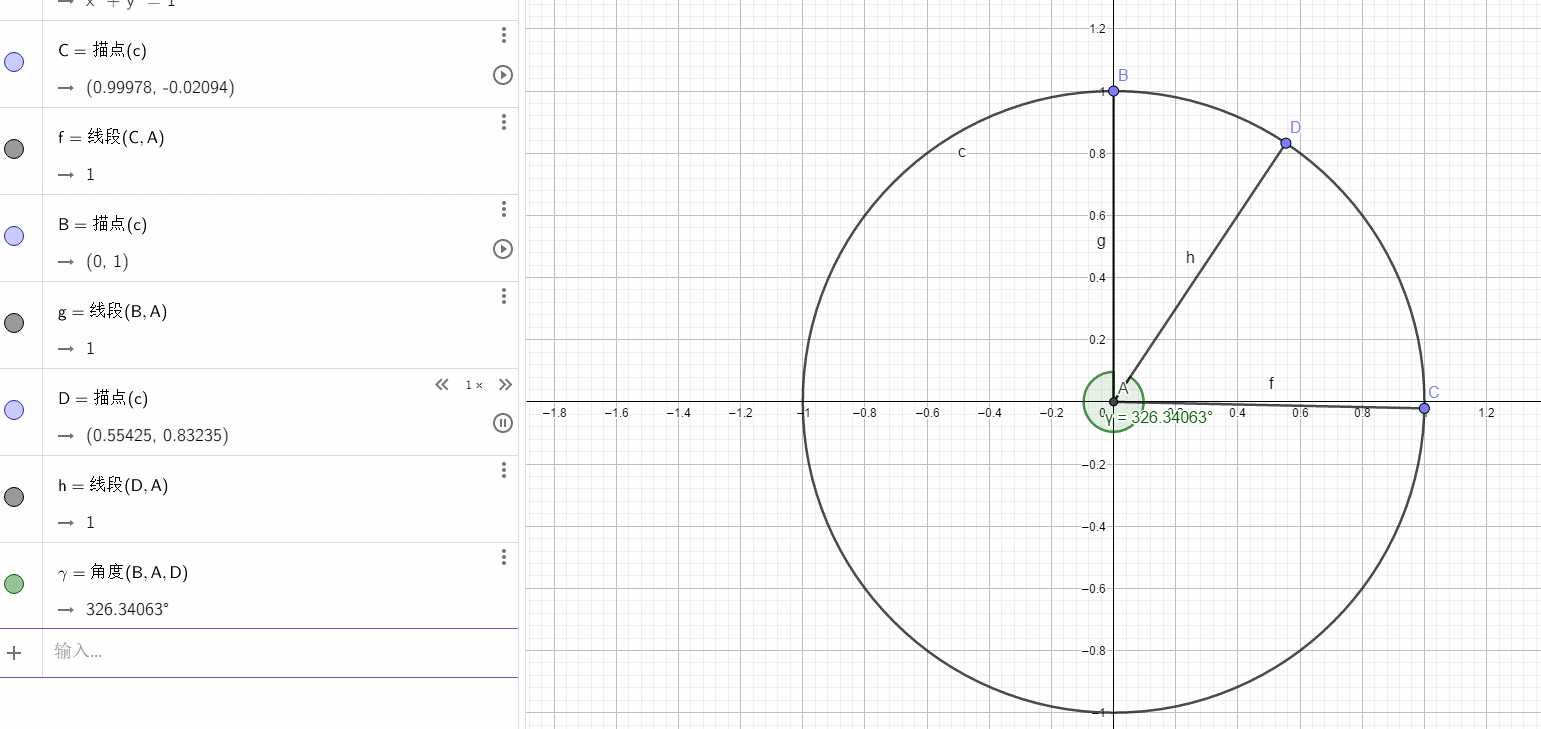WPF 透视相机的UpDirection(向上方向)
Posted lonelyxmas
tags:
篇首语:本文由小常识网(cha138.com)小编为大家整理,主要介绍了WPF 透视相机的UpDirection(向上方向)相关的知识,希望对你有一定的参考价值。
原文:WPF 透视相机的UpDirection(向上方向)
透视相机的updirection,是具有三个参数的的属性(X,Y,Z),不过Z属性是没有作用的。
也就是说这一个立体中的平面坐标系。
那么X,Y是什么呢?
我们知道在X,Y坐标轴系内单位圆上的点,都是可以用的cosX,sinY来表示。
网上找的图

假设,XY坐标系内画一个直径为1的圆(圆心[0,0])
确定好圆上的点连接圆心之后和Y轴之间的夹角之后再用反三角函数求出角度即可
比如说我用sin函数
当确定X,Y值后,点连接圆心,长度为1,圆心角的对边长度为X坐标,斜边长度为1(不知道为什么直接写1不好使,必须用勾股定理求一下斜边),之后再arcsin函数转角度就好了。
转换器
class MC : IMultiValueConverter { public object Convert(object[] values, Type targetType, object parameter, CultureInfo culture) { var v = Activator.CreateInstance(targetType,values); return v; // throw new NotImplementedException(); } public object[] ConvertBack(object value, Type[] targetTypes, object parameter, CultureInfo culture) { throw new NotImplementedException(); } } class Deg : IMultiValueConverter { public object Convert(object[] values, Type targetType, object parameter, CultureInfo culture) { double a = double.Parse(values[0].ToString()); double b = double.Parse(values[1].ToString()); var d = Math.Sqrt(a * a + b * b); Debug.WriteLine(d); var c = (Math.Asin(a/d )/Math.PI) * 180.0; return c.ToString(); } public object[] ConvertBack(object value, Type[] targetTypes, object parameter, CultureInfo culture) { throw new NotImplementedException(); } }
<Window.Resources>
<local:MC x:Key="mc"/>
<local:Deg x:Key="dc"/>
</Window.Resources>
<Grid>
<Grid.RowDefinitions>
<RowDefinition/>
<RowDefinition/>
</Grid.RowDefinitions>
<Viewport3D>
<Viewport3D.Camera>
<PerspectiveCamera Position="0,0,10" LookDirection="0,0,-10">
<PerspectiveCamera.UpDirection>
<MultiBinding Converter="{StaticResource mc}">
<Binding ElementName="s1" Path="Value"/>
<Binding ElementName="s2" Path="Value"/>
<Binding ElementName="s3" Path="Value"/>
</MultiBinding>
</PerspectiveCamera.UpDirection>
</PerspectiveCamera>
</Viewport3D.Camera>
<ModelVisual3D>
<ModelVisual3D.Content>
<DirectionalLight Color="White" Direction="-1,-1,-1"/>
</ModelVisual3D.Content>
</ModelVisual3D>
<ModelVisual3D>
<ModelVisual3D.Content>
<GeometryModel3D>
<GeometryModel3D.Geometry>
<MeshGeometry3D Positions="-1,0,0 0,1,0 1,0,0" TriangleIndices="0,2,1"/>
</GeometryModel3D.Geometry>
<GeometryModel3D.Material>
<DiffuseMaterial Brush="Red" />
</GeometryModel3D.Material>
</GeometryModel3D>
</ModelVisual3D.Content>
</ModelVisual3D>
</Viewport3D>
<Grid Grid.Row="1">
<Grid.ColumnDefinitions>
<ColumnDefinition/>
<ColumnDefinition/>
</Grid.ColumnDefinitions>
<StackPanel >
<Slider LargeChange="0.1" Maximum="1" Minimum="-1" Value="{Binding ElementName=c1, Path=Text,UpdateSourceTrigger=PropertyChanged}" x:Name="s1"/>
<Slider LargeChange="0.1" Maximum="1" Minimum="-1" Value="{Binding ElementName=c2, Path=Text,UpdateSourceTrigger=PropertyChanged}" x:Name="s2"/>
<Slider Maximum="10" Minimum="-10" Value="0" x:Name="s3"/>
</StackPanel>
<StackPanel Grid.Column="1">
<TextBlock Text="{Binding ElementName=s1,Path=Value}"/>
<TextBlock Text="{Binding ElementName=s2,Path=Value}"/>
<TextBlock Text="{Binding ElementName=s3,Path=Value}"/>
<TextBlock >
<TextBlock.Text>
<MultiBinding Converter="{StaticResource dc}">
<Binding ElementName="s1" Path="Value"/>
<Binding ElementName="s2" Path="Value"/>
</MultiBinding>
</TextBlock.Text>
</TextBlock>
<TextBox x:Name="c1"/>
<TextBox x:Name="c2"/>
</StackPanel>
</Grid>
</Grid>
值得注意的是 这个是旋转的是摄像机旋转,物体是不动的,也就是左右方向是反的。
最后上传
其他软件的对照角度和XY坐标,可以自己验证一下

以上是关于WPF 透视相机的UpDirection(向上方向)的主要内容,如果未能解决你的问题,请参考以下文章
